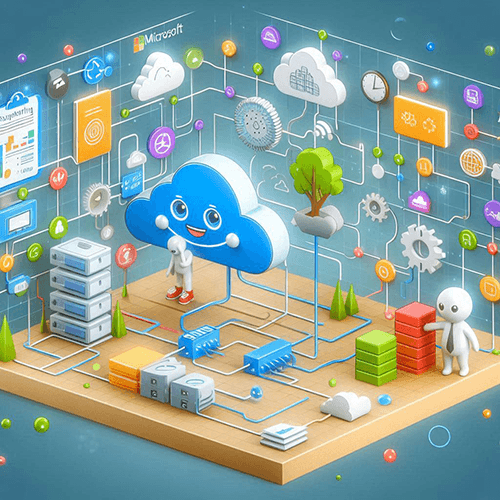Azure Cloud, DevOps resources and blog
-

How Microsoft Entra ID is used as a directory for cloud apps
Microsoft Entra ID (formerly Azure Active Directory, or Azure AD) is used as a cloud-based directory service that manages and secures user identities, access, and permissions for cloud applications. It serves as a central identity provider for applications, services, and resources both within Microsoft’s ecosystem… [ Read more ]
-

Azure Virtual Network explained in detail
Azure Virtual Network (VNet) is one of the fundamental building blocks in Azure that allows you to securely connect Azure resources to each other, the internet, and on-premises environments. It provides a private network where you can define and control the IP addressing, DNS settings,… [ Read more ]
-

Compare Microsoft Entra ID to Active Directory Domain Services (AD DS)
Microsoft Entra ID (formerly Azure Active Directory, or Azure AD) and Active Directory Domain Services (AD DS) are both identity and access management solutions provided by Microsoft, but they serve different purposes and are designed for different environments. Below is a comparison of the two:… [ Read more ]
-

Subnets and Subnetting in Azure – Features and Use-cases
In Azure, subnets are an integral part of your Virtual Network (VNet) architecture. Subnets allow you to partition a VNet's IP address space into smaller, more manageable segments. Subnetting helps you organize and control the flow of network traffic, segment security policies, and ensure efficient… [ Read more ]
-

Know everything about Azure Virtual Network – Features and Components
An Azure Virtual Network (VNet) is one of the foundational building blocks for your private network in Azure. It allows Azure resources to securely communicate with each other, the internet, and on-premises networks. Azure VNets provide isolation, segmentation, and secure communication between virtual machines (VMs),… [ Read more ]
-

Introduction to Artifacts in Azure DevOps
Introduction to Artifacts in Azure DevOps Azure Artifacts is a fully managed package management solution provided by Microsoft as part of Azure DevOps Services. It allows teams to host and share packages (such as libraries, frameworks, or application dependencies) in a secure and scalable manner.… [ Read more ]
-

Consuming Packages in Software Development with Azure DevOps
Consuming Packages in Software Development with Azure DevOps Consuming packages involves integrating third-party libraries, frameworks, or tools into your application. This process typically involves downloading a package from a package source or repository (whether it's a public or private repository) and incorporating it into your… [ Read more ]
-

Know about RBAC Authentication in Azure
Role-Based Access Control (RBAC) is a core feature in Azure that helps organizations manage access to resources by assigning permissions based on roles. RBAC plays a crucial role in authentication and authorization in Azure, as it controls who can access Azure resources, what they can… [ Read more ]
-

Exploring Self-Hosted and SaaS-Based Package Sources in Azure DevOps
Exploring Self-Hosted and SaaS-Based Package Sources in Azure DevOps In modern software development, managing dependencies and packages efficiently is crucial. Organizations need a way to host, share, and consume packages securely and at scale. Package sources (repositories) can either be self-hosted or SaaS-based (Software-as-a-Service). Both… [ Read more ]
-

Exploring common Public Package Sources in Azure DevOps
Exploring common Public Package Sources in Azure DevOps Exploring Common Public Package Sources Public package sources are centralized repositories where open-source packages are stored, shared, and made available for developers to use in their projects. These sources are an essential part of modern software development,… [ Read more ]
-

Exploring Package Feed Managers in Azure DevOps
Exploring Package Feed Managers in Azure DevOps A Package Feed Manager is a system or tool designed to help manage, organize, and distribute software packages within a feed, ensuring that packages are correctly versioned, stored, and made available to developers for installation and usage. These… [ Read more ]
-

Understanding Package Feeds in Azure DevOps
Understanding Package Feeds in Azure DevOps A package feed is a centralized repository where developers can publish, manage, and consume packages (such as libraries, tools, frameworks, and dependencies) for use in their software projects. Package feeds enable version control, dependency management, and easy distribution of… [ Read more ]
-

Exploring Packages in Azure DevOps
Exploring Packages in Azure DevOps In software development, a package is a collection of pre-written code that can be used by developers to perform specific tasks without the need to write those functionalities from scratch. Packages encapsulate libraries, modules, tools, and dependencies that can be… [ Read more ]
-

Learn how to Decompose your system in DevOps
Learn how to Decompose your system in DevOps Decomposing a system is a critical part of modern software engineering and involves breaking down a large, complex system into smaller, more manageable components or services. These components should be loosely coupled and highly cohesive, allowing them… [ Read more ]



















